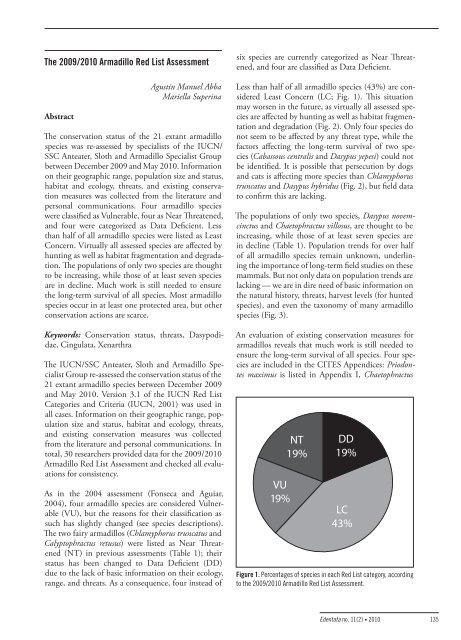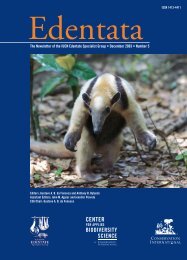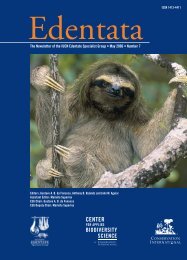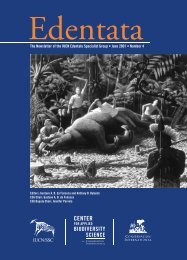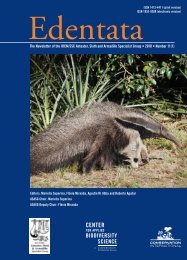Edentata 11(2), 2010 - Anteater, Sloth & Armadillo Specialist Group
Edentata 11(2), 2010 - Anteater, Sloth & Armadillo Specialist Group
Edentata 11(2), 2010 - Anteater, Sloth & Armadillo Specialist Group
- No tags were found...
Create successful ePaper yourself
Turn your PDF publications into a flip-book with our unique Google optimized e-Paper software.
The 2009/<strong>2010</strong> <strong>Armadillo</strong> Red List AssessmentAbstractAgustín Manuel AbbaMariella SuperinaThe conservation status of the 21 extant armadillospecies was re-assessed by specialists of the IUCN/SSC <strong>Anteater</strong>, <strong>Sloth</strong> and <strong>Armadillo</strong> <strong>Specialist</strong> <strong>Group</strong>between December 2009 and May <strong>2010</strong>. Informationon their geographic range, population size and status,habitat and ecology, threats, and existing conservationmeasures was collected from the literature andpersonal communications. Four armadillo specieswere classified as Vulnerable, four as Near Threatened,and four were categorized as Data Deficient. Lessthan half of all armadillo species were listed as LeastConcern. Virtually all assessed species are affected byhunting as well as habitat fragmentation and degradation.The populations of only two species are thoughtto be increasing, while those of at least seven speciesare in decline. Much work is still needed to ensurethe long-term survival of all species. Most armadillospecies occur in at least one protected area, but otherconservation actions are scarce.Keywords: Conservation status, threats, Dasypodidae,Cingulata, XenarthraThe IUCN/SSC <strong>Anteater</strong>, <strong>Sloth</strong> and <strong>Armadillo</strong> <strong>Specialist</strong><strong>Group</strong> re-assessed the conservation status of the21 extant armadillo species between December 2009and May <strong>2010</strong>. Version 3.1 of the IUCN Red ListCategories and Criteria (IUCN, 2001) was used inall cases. Information on their geographic range, populationsize and status, habitat and ecology, threats,and existing conservation measures was collectedfrom the literature and personal communications. Intotal, 30 researchers provided data for the 2009/<strong>2010</strong><strong>Armadillo</strong> Red List Assessment and checked all evaluationsfor consistency.As in the 2004 assessment (Fonseca and Aguiar,2004), four armadillo species are considered Vulnerable(VU), but the reasons for their classification assuch has slightly changed (see species descriptions).The two fairy armadillos (Chlamyphorus truncatus andCalyptophractus retusus) were listed as Near Threatened(NT) in previous assessments (Table 1); theirstatus has been changed to Data Deficient (DD)due to the lack of basic information on their ecology,range, and threats. As a consequence, four instead ofsix species are currently categorized as Near Threatened,and four are classified as Data Deficient.Less than half of all armadillo species (43%) are consideredLeast Concern (LC; Fig. 1). This situationmay worsen in the future, as virtually all assessed speciesare affected by hunting as well as habitat fragmentationand degradation (Fig. 2). Only four species donot seem to be affected by any threat type, while thefactors affecting the long-term survival of two species(Cabassous centralis and Dasypus yepesi) could notbe identified. It is possible that persecution by dogsand cats is affecting more species than Chlamyphorustruncatus and Dasypus hybridus (Fig. 2), but field datato confirm this are lacking.The populations of only two species, Dasypus novemcinctusand Chaetophractus villosus, are thought to beincreasing, while those of at least seven species arein decline (Table 1). Population trends for over halfof all armadillo species remain unknown, underliningthe importance of long-term field studies on thesemammals. But not only data on population trends arelacking — we are in dire need of basic information onthe natural history, threats, harvest levels (for huntedspecies), and even the taxonomy of many armadillospecies (Fig. 3).An evaluation of existing conservation measures forarmadillos reveals that much work is still needed toensure the long-term survival of all species. Four speciesare included in the CITES Appendices: Priodontesmaximus is listed in Appendix I, ChaetophractusVU19%NT19%DD19%LC43%Figure 1. Percentages of species in each Red List category, accordingto the 2009/<strong>2010</strong> <strong>Armadillo</strong> Red List Assessment.<strong>Edentata</strong> no. <strong>11</strong>(2) • <strong>2010</strong> 135


